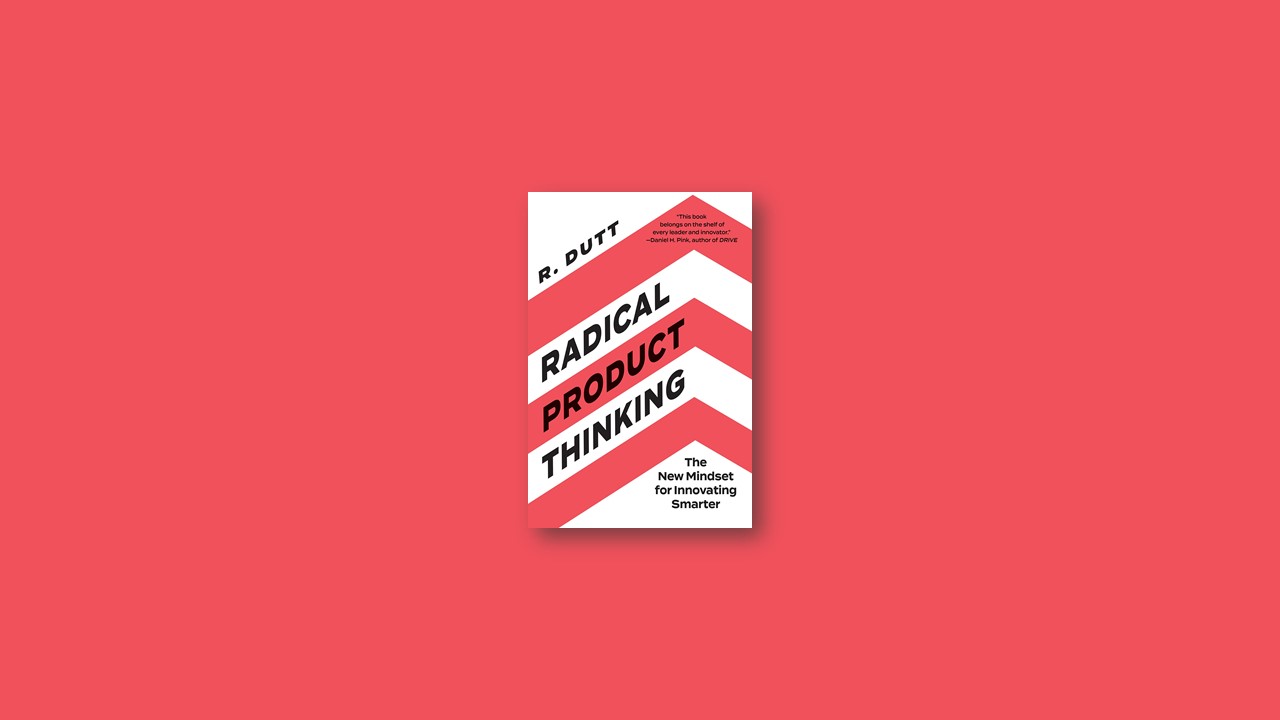Why We Need Radical Product Thinking
- An iteration-led approach can move financial KPI up and to the right, but it doesn’t guarantee that you’ll build game-changing products.
- In an iteration-led model, iteration defines where you go. In a vision-driven approach, iteration helps you refine how you get to your destination.
- Radical Product Thinking helps you build vision-driven products that help you create the change you envision.
- Here are the three pillars of the RPT philosophy:
- Think of your product as your mechanism for creating change.
- Envision the change you want to bring to the world before engineering your product.
- Create change by connecting your vision to your day-today activities.
- Radical Product Thinking gives you direction, Lean and Agile give you speed. Together you get speed plus direction (i.e., velocity).
- In the RPT way, anything can be your product if it is your constantly improving mechanism to create the change you want to bring about.
Product Diseases: When Good Products Go Bad
These seven diseases are common across industries and sizes of organizations:
- Hero Syndrome strikes when we focus on external recognition instead of creating the change that inspires us.
- Strategic Swelling means building a wide range of capabilities but lacking the focus to develop any individual capability to a breakthrough level.
- Obsessive Sales Disorder means borrowing against the long-term vision to close short-term deals.
- Hypermetricemia is focusing excessively on measurable outcomes to determine success, irrespective of whether those are the right things to measure.
- Locked-In Syndrome means overly committing to a specific technology or approach because it has been successful in the past.
- Pivotitis means changing direction whenever things get tough and leads to exhausted, confused, and demoralized teams.
- Narcissus Complex means focusing on your own goals and needs to such an extent that you lose focus on the change you’re trying to bring about.
These diseases can be cured by starting with a clear vision and systematically translating it into your everyday activities.
Vision: Envisioning Change
Crafting a compelling vision is the first step to envisioning the change you want to bring to the world.
- A good vision is
- Centered on the problem you want to see solved in the world.
- A tangible end state you can visualize.
- Meaningful to you and the people you intend to impact.
Once you have a clear vision, it’s time to spread your vision:
- Get buy-in from the team by cocreating your vision using the Radical Vision Statement template.
- Help your team internalize the vision by observing users’ frustrations with the status quo and seeing how your solution will make users’ lives better.
- Cultivate visionaries by empowering every team in your organization to craft a vision statement that aligns with the organization’s vision. Show individuals how their work contributes toward the team’s and organization’s vision.
Strategy: Connecting the Why with the How
Your product strategy is how you translate your vision into an actionable plan.
- A comprehensive product strategy answers the following four questions (an easy-to-remember mnemonic is RDCL, pronounced “radical”):
- Real pain points: What’s the pain that triggers someone to use your product? Remember that the pain points are real only if you’ve validated them: Validated = Verified + Valued.
- Design: What functionality in your offering solves that pain? Design means thinking of the interface (how you want the product to be used) and the identity (how you want the product to be perceived).
- Capabilities: What capabilities or infrastructure do you need to deliver on the promise of the solution? Capabilities can be tangible (e.g., data, intellectual property, contracts, people) or intangible (e.g., relationships, skills, partnerships, trust).
- Logistics: How do you deliver the solution to your users? How do you price it and support it? Logistics is often an element of strategy that is bolted on as an afterthought. Your revenue and cost model, training, and support plan should be considerations in your product development plan.
- Once you’ve crafted a RDCL strategy, you can use iterations to test and refine your strategy.
Prioritization: Bringing Balance to the Force
In the Radical Product Thinking way, the two-by-two prioritization rubric is a strategic tool to help you communicate your rationale for prioritization and decision-making. To get started, define your two axes: vision fit and survival.
- Survival is defined by the question, “What is the biggest risk that could kill your product tomorrow?”
- The two-by-two naturally creates a facilitative approach for decision-making where teams can evaluate trade-offs by placing initiatives, opportunities, tasks, or features into the four quadrants:
- Ideal quadrant: Helps you make progress toward the vision and lowers risk
- Investing in the Vision quadrant: Helps you make progress toward the vision but increases risk in the short term
- Building Vision Debt quadrant: Helps you survive in the short term but takes you further away from achieving your vision
- Danger! quadrant: Takes you away from your vision and increases risk
- Examples of how you can use this approach to prioritization and decision-making include the following:
- Communicating your strategic plan and its rationale to your team and board
- Structuring conversations to make difficult decisions
- Sharing your intuition on product decisions or trade-offs
Culture: Radical Product Thinking Your Organization
- In the Radical Product Thinking way, culture can be your product: your mechanism for creating an environment that maximizes intrinsic motivation and minimizes anything that detracts from it.
- You can think of your culture as the cumulative set of your experiences during your workday.
- The RPT rubric for culture helps you see your workday along two dimensions: whether work is satisfying or depleting and whether it’s urgent or not. The rubric reveals the following four quadrants:
- Meaningful Work: Satisfying but not urgent work that makes you feel like you’re making progress toward a larger purpose
- Heroism: Satisfying work that’s urgent and adds spice to your workday but can lead to burnout
- Organizational Cactus: Tasks that are depleting but urgent; some amount is necessary in any organization, but too much is painful
- Soul-Sucking: Depleting and not urgent work that slowly sucks energy out of you
- This framework helps you develop a clear vision for your culture: making the Meaningful Work quadrant larger and the danger quadrants smaller.
- Understanding the activities in each quadrant is key to crafting a RDCL strategy to address the root cause behind the time spent in each of the danger quadrants.
- To create diversity on a team, you need to acknowledge that people of color are most likely experiencing a culture where the danger quadrants are larger than the Meaningful Work quadrant.
- A good organizational culture has psychological safety, which can be deliberately created by modeling the following:
- Fallibility: Making it okay to be wrong and to learn from mistakes
- Direct communication: Caring personally and therefore challenging directly
- Accessibility: Increasing the frequency of interactions so that it’s easier to take interpersonal risks
Digital Pollution: The Collateral Damage to Society
Digital pollution is the collateral damage to society from unregulated tech growth, just as environmental pollution is the damage from unregulated industrial growth.
- We may be tempted to think that just a few tech giants create digital pollution. In reality, unintended consequences and digital pollution are pervasive.
- Digital pollution frays the fabric of society in five major ways:
- Fueling inequality
- Hijacking attention
- Creating ideological polarization
- Eroding privacy
- Eroding the information ecosystem
- The responsibility of societal well-being cannot fall to charities alone—businesses affect many millions more people.
- You can build vision-driven products that avoid digital pollution—anything can be your product if it is your mechanism to create change.
Ethics: The Hippocratic Oath of Product
- In building a product, your role is much like that of a doctor. You’re solving a problem for your users and it comes with the responsibility of their well-being.
- Prisoner’s Dilemma helps illustrate the decision-making rationale of building products to maximize individual gain versus building responsibly.
- If everyone maximizes for individual gain, as a society we’re heading toward a suboptimal outcome of unabated digital pollution.
- To avoid this outcome we need to consider a holistic approach that includes the three Is:
- Intimidation/Consequences: Regulations to discourage bad behavior
- Incentives: External motivation to encourage building responsibly
- Inspiration: Awareness of how we affect society, tapping into our hardwired desire to maximize our collective well-being
- Compartmentalizing business as a mechanism to maximize profitability and philanthropy as a way of doing good isn’t effective if we want to create a better world through our products.


